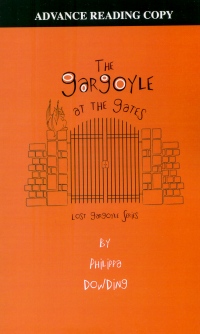| ________________
CM . . .
. Volume XIX Number 1. . . .September 7, 2012 
 |
The Gargoyle at the Gates. (Lost Gargoyle Series).
Philippa Dowding.
Toronto, ON: Dundurn, 2012.
188 pp., pbk., $10.99.
ISBN
978-1-4597-0394-0.
Grades 4-6 / Ages 9-11.
Review by Daphne Hamilton-Nagorsen.
*** /4
Reviewed from Advance Reading Copy.
|
| |
|

excerpt:
Ambergine came out of the bushes first and stepped into the spotlight near the apple tree (still magically bearing fruit). She looked up at the boy in the window and did a little curtsy. Then she started spiraling and pirouetting in the snow, dancing to the guitar music (she was amazingly dainty, for a gargoyle). Slowly, reluctantly, Gargoth joined her (he couldn't help himself), and there in the snowy, strange little gothic park, Christopher watched the two ancient creatures dance and pirouette and move together in a gargoyle ballet as the snow fell gently upon them.
Christopher loved the ritual of the night time guitar serenade, but he had to be careful, because Gargoth had discovered (through peeking out of the bushes and watching the older Cannings) that snow could be patted into a ball and used as a very effective projectile. Christopher never knew if a "snow apple" was going to whiz at him as he played guitar. He had to keep a sharp eye out, but that was happening less and less these days.
The Gargoyle at the Gates is the third book in the "Lost Gargoyle" series by Philippa Dowding. The majority of the story focuses on Christopher Canning, Gargoth and Ambergine, with the remainder following James (a member of the Tallus family who created the gargoyles) and the other three living gargoyles. This focus puts familiar characters from the first two books, such as Katherine and Cassandra, into the role of supporting rather than primary characters. However, the introduction of Christopher and James keeps the story fresh and interesting for readers while still bringing older characters into the story.
The additional gargoyles show that each gargoyle has its own distinct personality, thereby increasing the appeal of the gargoyles to readers as well as showing the detail that Philippa Dowding puts into her story. Gargoth and Ambergine show their emotions and feelings through internal dialogue while the other three show their emotions only through their actions. This approach is still enough to see the uniqueness of each gargoyle. All the gargoyles show themselves to have very human feelings and emotions, such as Gargoth's sadness and self-reproach after The Collector kidnaps Ambergine. This style of writing draws readers into the story and into the themes being explored.
The primary themes of The Gargoyle at the Gates are the same as the first two books, mainly friendship and loneliness. The themes are seen primarily with Christopher and the beginnings of his friendships with Gargoth and Ambergine, as well as Christopher's experiences in a new city. This is repeated with James as he gets to know both his grandfather and three gargoyles. The depth of Gargoth and Ambergine's friendships with their human friends (Katherine, Cassandra and Christopher) is shown in the determination of the humans to save the gargoyles from The Collector and the lengths the humans will go to ensure the gargoyles are safe.
Having gargoyles as the main characters allows Philippa Dowding to approach the themes of the story in a very age-appropriate way and to keep those themes accessible to younger readers while still making them interesting to older readers. The themes are also firmly interwoven into the story, and no pauses are necessary to explain that The Collector is bad or Gargoth is sad. The dark side of The Collector, Gargoth's emotions and other aspects of the themes are easily shown through the actions of the characters, which make them more interesting and keep the story moving along.
As with the previous books, The Gargoyle at the Gates progresses at a good pace, one which will allow younger readers to keep up with the story while keeping the attention of older readers. Breaking the story up by interjecting James' story also helps to keep the readers following the story, not only by introducing the other three gargoyles, but also by making the reader wonder how this will all tie together in the end. Dowding smoothly moves the story between two locations and through the time period covered.
The Gargoyle at the Gates, an interesting and appealing story, is a splendid sequel to the first two Lost Gargoyle books.
Recommended.
Daphne Hamilton-Nagorsen is a graduate of the School of Library, Archival and Information Studies at the University of British Columbia in Vancouver, BC.

To comment
on this title or this review, send mail to cm@umanitoba.ca.
Copyright © the Manitoba Library Association. Reproduction for personal
use is permitted only if this copyright notice is maintained. Any
other reproduction is prohibited without permission.
NEXT REVIEW |
TABLE OF CONTENTS FOR THIS ISSUE
- September 7, 2012.
AUTHORS |
TITLES |
MEDIA REVIEWS |
PROFILES |
BACK ISSUES |
SEARCH |
CMARCHIVE |
HOME |
